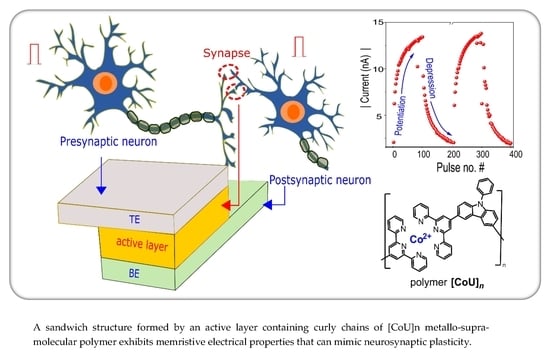Synapse-Mimicking Memristors Based on 3,6-Di(tpy)-9-Phenylcarbazole Unimer and Its Copolymer with Cobalt(II) Ions
Abstract
Share and Cite
Pandey, A.; Chernyshev, A.; Panthi, Y.R.; Zedník, J.; Šturcová, A.; Konefał, M.; Kočková, O.; Foulger, S.H.; Vohlídal, J.; Pfleger, J. Synapse-Mimicking Memristors Based on 3,6-Di(tpy)-9-Phenylcarbazole Unimer and Its Copolymer with Cobalt(II) Ions. Polymers 2024, 16, 542. https://doi.org/10.3390/polym16040542
Pandey A, Chernyshev A, Panthi YR, Zedník J, Šturcová A, Konefał M, Kočková O, Foulger SH, Vohlídal J, Pfleger J. Synapse-Mimicking Memristors Based on 3,6-Di(tpy)-9-Phenylcarbazole Unimer and Its Copolymer with Cobalt(II) Ions. Polymers. 2024; 16(4):542. https://doi.org/10.3390/polym16040542
Chicago/Turabian StylePandey, Ambika, Andrei Chernyshev, Yadu Ram Panthi, Jiří Zedník, Adriana Šturcová, Magdalena Konefał, Olga Kočková, Stephen H. Foulger, Jiří Vohlídal, and Jiří Pfleger. 2024. "Synapse-Mimicking Memristors Based on 3,6-Di(tpy)-9-Phenylcarbazole Unimer and Its Copolymer with Cobalt(II) Ions" Polymers 16, no. 4: 542. https://doi.org/10.3390/polym16040542
APA StylePandey, A., Chernyshev, A., Panthi, Y. R., Zedník, J., Šturcová, A., Konefał, M., Kočková, O., Foulger, S. H., Vohlídal, J., & Pfleger, J. (2024). Synapse-Mimicking Memristors Based on 3,6-Di(tpy)-9-Phenylcarbazole Unimer and Its Copolymer with Cobalt(II) Ions. Polymers, 16(4), 542. https://doi.org/10.3390/polym16040542










